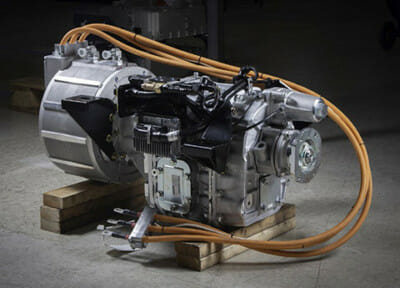Lightning eMotors electric vehicles: Sustainability
This article discusses the benefits of battery-electric commercial vehicles from a sustainability perspective, primarily focusing on emissions but also looking at the end-to-end environmental impact of the products. You can find a PDF of this article here.
A quick look at automotive pollutants…
Automotive pollutants fall into two main categories:
Air quality pollutants – These degrade the air quality in a region. Poor air quality impacts human health and leads to hospitalizations and deaths. Air quality pollutants include:
- NOX (oxides of nitrogen), a product of internal combustion engines and a major component of urban smog because it reacts with sunlight to produce ozone.
- CO (carbon monoxide), a minor product of internal combustion engines, but toxic when in high concentrations.
- VOCs (volatile organic compounds), such as evaporating fuels and solvents, are also a component of smog, as well as a health hazard.
- PM (particulate matter), which includes diesel soot, brake dust, tire dust and road dust, impacts our lungs directly.
Greenhouse gases – These capture heat in the atmosphere and are contributing to man-made global warming. Examples are:
-
- CO2 (carbon dioxide), which is the main product of all fossil fuel combustion.
- CH4 (methane, a.k.a. natural gas), a fuel used in some commercial vehicles.
Let’s start with on-road emissions…
A battery-electric vehicle emits no CO2. There’s no fossil fuel combustion, so there’s no carbon dioxide.

There is also no NOX, no CO and no CH4. And since there’s no fuel, VOCs are much reduced, though a new vehicle will probably emit adhesive solvents for a while.
The emissions of particulate matter (PM) are also improved:
- No diesel soot.
- And brake dust is reduced due to the use of regenerative braking (“regen”), where the vehicle slows down by using the electric motor as a generator to drive some charge into the batteries.
However, tire dust and road dust emissions are unchanged relative to a conventional vehicle.
So, a battery-electric vehicle scores very well regarding on-road emissions.
Comparing CO2 emissions with gasoline and diesel vehicles…
Reducing carbon dioxide emissions comes at the top of any list of sustainability priorities, so how does a battery-electric vehicle compare with its internal combustion cousins?
According to the US Environmental Protection Agency (EPA) (link1, see table 2):
- Burning one US gallon of diesel fuel produces 22.5 lbs of CO2.
- Burning one US gallon of gasoline produces 19.4 lbs of CO2.
Therefore, a diesel vehicle which does 8 miles to the gallon will emit 281 lbs of CO2 per 100 miles. Or a gasoline vehicle which gets 12 miles to the gallon will emit 162 lbs of CO2 per 100 miles.
A battery-electric vehicle emits no CO2 at all. At first glance, this appears to make it easy to calculate how many pounds of CO2 you’ll save each year if you replace your conventional vehicles with EVs. However, for a more complete picture, we need to take a look at where the electricity comes from.
The grid…
The electricity used to charge a battery-electric vehicle usually comes from “the grid”, which is the infrastructure which delivers electricity from one or more power stations to the end user. Depend- ing on the type of power station, CO2 may be emitted:
- Coal, natural gas, oil-fired and biomass power plants emit CO2 as a product of combustion.
- Nuclear, solar, wind, geothermal, hydro and tidal do not emit CO2.
So how do an EV’s CO2 emissions compare with gasoline and diesel when we take the grid into account?
For coal-fired power stations, which are the most CO2-intensive, the emissions are approximately 1.9 lbs of CO2 per kilowatt-hour (kWh) of electricity generated (EPA link table 1, and Wikipedia for efficiency values). Since a commercial EV travels about 1 mile per kWh (say for class 5), that’s 190 lbs of coal-generated CO2 per 100 miles of range. That falls between our diesel and gasoline example vehicles above.
However, natural gas (methane) power stations are taking over from coal in most US markets. They emit 35% of the CO2 that coal emits for the same electricity output, so if your local grid is 100% natural gas powered, your EV’s carbon emissions are 65 lbs of CO2 per 100 miles, which is 4.3x less CO2 than the diesel vehicle.

But most regional grids have a mix of power generation types which include nuclear and renewable (primarily solar and wind). For example, California’s mix (as of 2018, Wikipedia) has 43.8% natural gas, a little wood/biomass combustion and almost no coal. All of the rest of the generation capacity comes from solar, hydro, nuclear, wind and geothermal, none of which emit CO2.
With this mix, CO2 emissions for a battery-electric commercial vehicle driving 100 miles in California are about 29 lbs of CO2. That’s 5.5x less than our gasoline vehicle, and 9.7x less than the diesel vehicle.
Taking it even further, Lightning Systems is currently working with our largest investor, BP, to map out microgrid options for our large fleet customers. We will partner with BP and other companies to create on-premises or close-proximity power stations with solar, natural gas, and energy storage. In this scenario, the CO2 footprint will be at least as low as California’s, and in cases where solar is used at scale, much lower.
What about raw materials and manufacturing?
Lightning currently supports two vehicle scenarios: a used vehicle and a new vehicle. In the case of a used vehicle (“retrofit” or “repower”), by repowering it we are keeping that vehicle out of the landfill and avoiding the impact of manufacturing a new vehicle. This is clearly the most sustain- able option when the vehicle can be re-powered. But sometimes a new vehicle is required. In that case, most Lightning Systems EVs are conversions of new stock vehicles from major OEMs such as Ford and GM. While in some markets it’s possible to obtain “gliders”, which are vehicles without an engine and transmission, that’s only the case for some of our platforms. This means that in many cases, the stock engines and transmissions are removed, and an electric motor and associated transmission are installed. This leads to a greater manufacturing footprint, which implies greater use of resources and energy than for a stock OEM vehicle.
In addition, the vehicle’s batteries include lithium and other materials, and there’s a materials and energy footprint associated with that too, as well as the environmental impact of lithium mining.
Therefore, the end-to-end sustainability impact of putting an EV on the road is greater in some cases than for a conventional vehicle and may somewhat offset the EV’s on-road advantages.
However, the EV industry is young and the situation will improve over time. For example, most of the OEM relationships Lightning Systems foresees in the future will include gliders. And, of course, as the world’s mix of power generation sources becomes increasingly clean, the CO2 impact of manufacturing will only decrease.
Ultimately, Lightning Systems is looking beyond lithium-based batteries. This aligns with the EV industry as a whole that sees lithium as an intermediate step to new, greener technologies.
What about end-of-life and recycling?

The electric motor is easy and cost-effective to recycle, as it consists mostly of iron, steel, aluminum and copper.
At this time, lithium-based EV batteries are not cost-effective to recycle, though there is a push in the industry to address this. Lithium battery components consigned to landfills are not regarded as hazardous waste if processed appropriately, though some jurisdictions do classify them as hazardous.
However, large EV batteries which have reached the end of their useful life in a vehicle can be redeployed in less-demanding applications such as on-site energy storage, for example in the microgrid application mentioned above, in mobile charging solutions or at events or in disaster relief situations.
Download this article as a PDF.
 Sign up to download our informative free guide, Electric Commercial Vehicles: What To Look For
Sign up to download our informative free guide, Electric Commercial Vehicles: What To Look For
 Get our Emissions Guide!
Get our Emissions Guide!
Although we call our commercial EVs “zero emission” vehicles, the truth is more complicated and depends on many factors. This guide explains how EVs stack up against gasoline and diesel vehicles when it comes to emissions, and includes a helpful worksheet for calculating the annual CO2 reductions you’d see if you electrify your fleet.
Sign up now to download our free Emissions Guide!